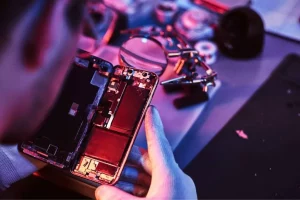In the realm of best methods for water damage phone repair, precise engineering is crucial for restoring functionality after liquid exposure. With advancing technology, phone components require meticulous care. Effective methods include immediately powering off the device to prevent short-circuiting, carefully drying the exterior, and removing any removable parts like SIM cards and batteries. Using silica gel or professional drying equipment can help absorb moisture. For comprehensive repairs, seeking expert services that use specialized tools and techniques ensures the device is restored to optimal functionality. Exploring these nuanced methods will help ensure successful restoration and preserve the integrity of your phone.
Key Takeaways
- Thoroughly assess water damage extent with specialized diagnostics.
- Implement precise component repair or replacement techniques.
- Utilize advanced water damage treatment methods for optimal results.
- Conduct detailed testing post-repair to ensure full functionality.
- Entrust experienced technicians for professional water damage phone repair services.
Recognizing Water Damage Signs
The identification of water damage signs on a phone is essential for determining the extent of the damage and initiating the appropriate repair procedures. Signs include a malfunctioning touch screen, distorted display, or water condensation under the screen. Additionally, indicators like red water damage indicators or erratic behavior post-exposure to water can signal internal damage. Prompt recognition of these signs aids in effective repair strategies.
Immediate Steps After Water Exposure
Upon exposure to water, it is important to promptly take action to mitigate potential damage to a phone. To begin with, power off the device to prevent short circuits. Do not attempt to charge or use it. Remove any accessories, SIM card, and memory card. Gently pat the phone with a dry cloth to remove excess water. Avoid using heat sources like a hairdryer, as they can cause further damage.
Drying Techniques for Waterlogged Phones
To effectively dry a waterlogged phone, it is essential to utilize proven techniques that prioritize thorough moisture removal while minimizing the risk of further damage. Methods such as using desiccants, rice, or silica gel packets in an enclosed container can aid in absorbing moisture. Additionally, employing a low heat source like an air circulator or dehumidifier can expedite the drying process without causing harm to the phone’s internal components.

Cleaning Components Safely
When addressing water damage phone repair, it is crucial to approach the cleaning of components with meticulous care to uphold the integrity and functionality of the device. Use isopropyl alcohol and a soft brush to gently clean any corrosion or debris from the circuit board. Confirm all residue is removed, especially around connectors. Finish by allowing the components to thoroughly dry before reassembly to prevent further damage or short-circuiting.
Professional Repair Options
Professional repair options for water-damaged phones cover a range of specialized services offered by experienced technicians with expertise in restoring electronic devices affected by liquid exposure. These services may involve detailed diagnostics to assess the extent of the damage, precise component repair or replacement, advanced water damage treatment techniques, and thorough testing to guarantee the phone functions properly post-repair. Trusting your device to such professionals can notably boost the chances of successful restoration.
Frequently Asked Questions
Can Rice Really Fix Water Damage in Phones?
Rice is a common household remedy believed to absorb moisture from water-damaged phones. While it may help in some cases by removing external moisture, it can’t address internal damage. Professional repair services are recommended for thorough restoration.
Is It Safe to Use a Hairdryer to Dry a Wet Phone?
Using a hairdryer to dry a wet phone is not recommended as the heat can potentially damage internal components. It is safer to utilize alternative methods like silica gel or rice to absorb moisture effectively.
Should I Try Disassembling My Phone for Water Damage Repair?
Disassembling a phone for water damage repair can be complex and risky. Without proper tools and expertise, it may cause further damage. It’s recommended to seek professional help to guarantee a safe and effective repair process.
How Long Should I Wait Before Turning on a Water-Damaged Phone?
For best results, it is recommended to wait at least 48 hours before attempting to turn on a water-damaged phone. This allows sufficient time for the internal components to dry completely, reducing the risk of short circuits and further damage.
Are DIY Water Damage Repair Kits Effective for Phones?
DIY water damage repair kits can be effective for phones if used with caution. However, success rates vary depending on the level of damage and expertise of the user. It’s recommended to follow manufacturer instructions meticulously for best results.
Conclusion
To sum up, identifying water damage indicators, taking prompt actions after exposure, utilizing correct drying methods, safe cleaning practices, and considering professional repair options are essential components of efficient phone repair. By approaching water damage restoration with engineering precision and attention to detail, the functionality of the device can be restored with accuracy and precision. Following these methods guarantees a thorough restoration process and peak functionality post-repair.
Also Read: Benefits of Holistic Healing in Business

